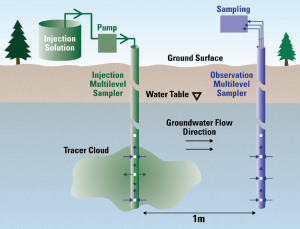Investigation of subsurface contamination migration is a challenging process, especially since we can’t see what’s underground with our own eyes. Tracer testing can give a view, of sorts, of what we can’t actually see. Tracer tracing is, simply, injecting a tracer fluid into an aquifer to establish one or more of the following: Where and how the water is traveling, the velocity of which it is traveling, or if a sensitive surface water body may be receiving impacted groundwater. This method of investigation can give great insight into the behavior of a groundwater contaminant plume, and comes at a relatively small cost.
There are a wide variety of tracer fluids that can be used to study water flow. For instance, fluorescent dyes are very easily detectable and can be used for scenarios where there is insufficient lighting or a need for precise quantitative data. These dyes can be fluorescein dyes, meaning they can be detected at very low concentration with a black light. Activated carbon samplers are used to calculate the concentration of a dye at a receptor location. Salt water tracers can track the time it takes water to move through an aquifer by measuring the changes in the electrical conductivity at several observation points.
How Dye Tracers Cut Investigation Costs
Tracer tests can give us a better understanding of the hydrogeology of a project site, especially in more complex situations. They’re commonly used in situations where there is an abundance of fractures in the bedrock, making the calculation of groundwater flow more difficult. Without dye tracers, this scenario would call for more borings to be drilled to fill the data gaps, driving investigation costs up. A dye tracer test can provide the increased data density necessary when developing a cost-effective remediation strategy, without the need for additional drilling.

How Dye Tracer Tests are set up
Here’s how a tracer test works. First, we establish a monitoring network, starting from a release point, to a set of downgradient wells. Then, we select the dye we’d like to use, choosing the least reactive dye to the geological conditions to better mimic the groundwater flow. We then pick a measuring device (activated carbon sampler, electrical conductivity data logger), release the dye, and monitor. Following the monitoring period and after all the data is collected and checked for quality control, calculations are completed and conclusions from the test information can be integrated into the CSM.
Helping Deliver Cost-Effective Remediation
Dye tracer testing is a useful way to save our clients and other project stakeholders money. It’s a cheap solution for scenarios where more data is needed to better understand the subsurface geology, and allows our team to pinpoint contaminant hot spots and exposure pathways with greater ease and accuracy, leading to more cost-effective cleaning solutions.



